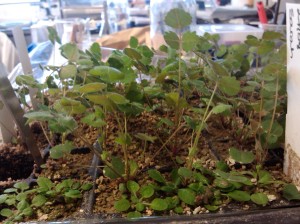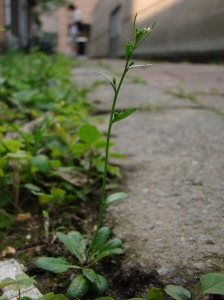The flowering plant Arabidopsis thaliana (also known as thale cress) is a small weed belonging to the Brassicaceae family that originates from Western Eurasia. Other members of this family include crops such as cabbage and oil seed rape, but A. thaliana itself has no uses in agriculture. Despite this, it is commonly used in research as a “model organism” to study a range of processes in plants from seedling growth to plant defence against disease.
A. thaliana has many characteristics that make it easy to use in experiments, including a small genome, short life cycle (as little as 6-8 weeks) and the ability to reproduce by self-fertilization. However, these characteristics also make it quite unusual compared to other flowering plants and even amongst its closest relatives in the Arabidopsis genus.
To understand more about the origins of A. thaliana’s unusual features we need to take a look at its natural history. It is a rapidly growing plant that can colonize disturbed soil and happily grows in stony or sandy soils that are low in nutrients. Its closest relatives (e.g. A. lyrata and A. halleria) are also found in bare rocky habitats, but grow more slowly with longer lifespans as biannuals (2 years) or perennials, which can live for many years.
A. thaliana is smaller in size than most of its closest relatives. Each plant produces many more seeds, which are smaller and can survive in the soil for longer periods of time than those of other Arabidopsis species. A. thaliana seeds are mostly the product of self-fertilization, whereas other Arabidopsis species reproduce by mostly or exclusively “out-crossing” (where pollen from one individual fertilizes the egg cells of another). Altogether, A. thaliana’s characteristics enable it to thrive and reproduce in various environments, and to quickly take advantage of new opportunities before other plants can establish themselves. During my PhD, I frequently found unwanted A. thaliana plants growing in my experiments (see image below).

A. thaliana (front) growing as a weed in my experiment with Medicago truncatula plants that had only been sown 4-weeks before.
Why has A. thaliana adopted such a different survival strategy to its closest relatives? It is thought that A. thaliana split from the common ancestor of other Arabidopsis species around 5 million years ago. This coincides with a transition in the Earth’s climate from a relatively warm period to much a colder climate with several ice ages. In these conditions, A. thaliana’s lifestyle would have had many advantages and is likely to have allowed it to live in a wider geographic area and climatic range than its closest relatives. In the last 100 years, A. thaliana has continued to expand its range by migrating to and across North America, southward in Africa and more recently to East Asia in association with human activities.
Some of A. thaliana’s characteristics can impose limitations on research. For example, much of our molecular knowledge about how plant roots grow comes from studies in A. thaliana even though it has a much simpler root structure than many other species. While this makes it easier to carry out experiments on the roots, it also means that our understanding of how plant roots grow is based on an exception, instead of the “norm”. Therefore, it is also important to translate our knowledge of the inner workings of A. thaliana into other plant species. This may involve carrying out experiments on a crop plant of interest, or using another “model” plant that is more closely related to it, for example, a grass called Brachypodium distachyon is often used as a model for wheat.
Studying A. thaliana alongside other members of the Arabidopsis genus may help us to understand the molecular basis of some of the characteristics A. thaliana is missing. Also, it may shed new light on how the loss of these traits has affected the natural history of this famous weed.
This post is based on an article by Ute Krämer published in the journal eLife as part of a special series called the “Natural History of Model Organisms”. Other species covered in this series include maize, the bacterium E.coli and the zebrafish.
Reference:
Krämer (2015) The natural history of model organisms: Planting molecular functions in an ecological context with Arabidopsis thaliana. eLife 4:e06100

Pingback: Recommended reads #54 | Small Pond Science
This is the way to go in Agricultural Research.
Thank you